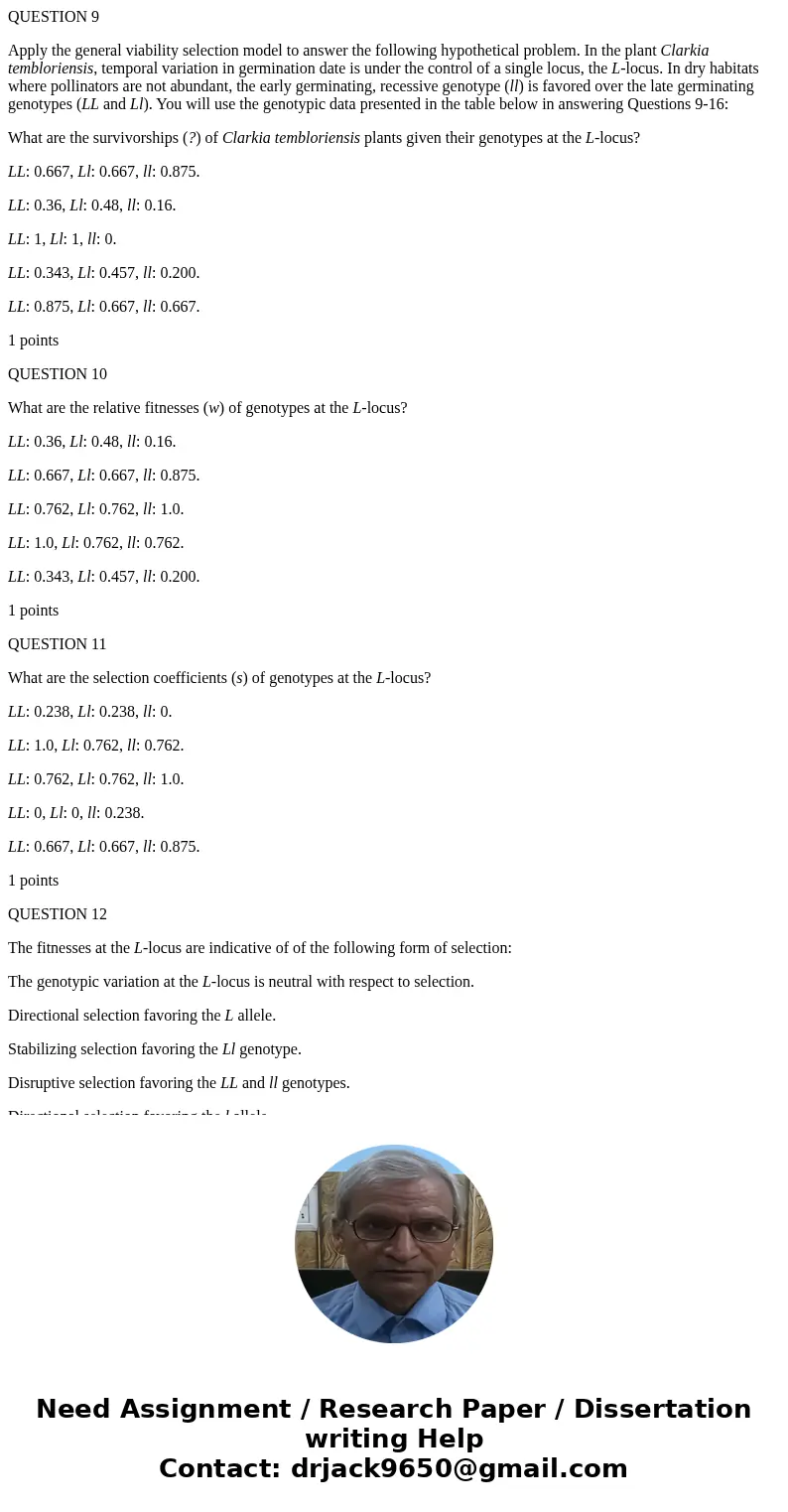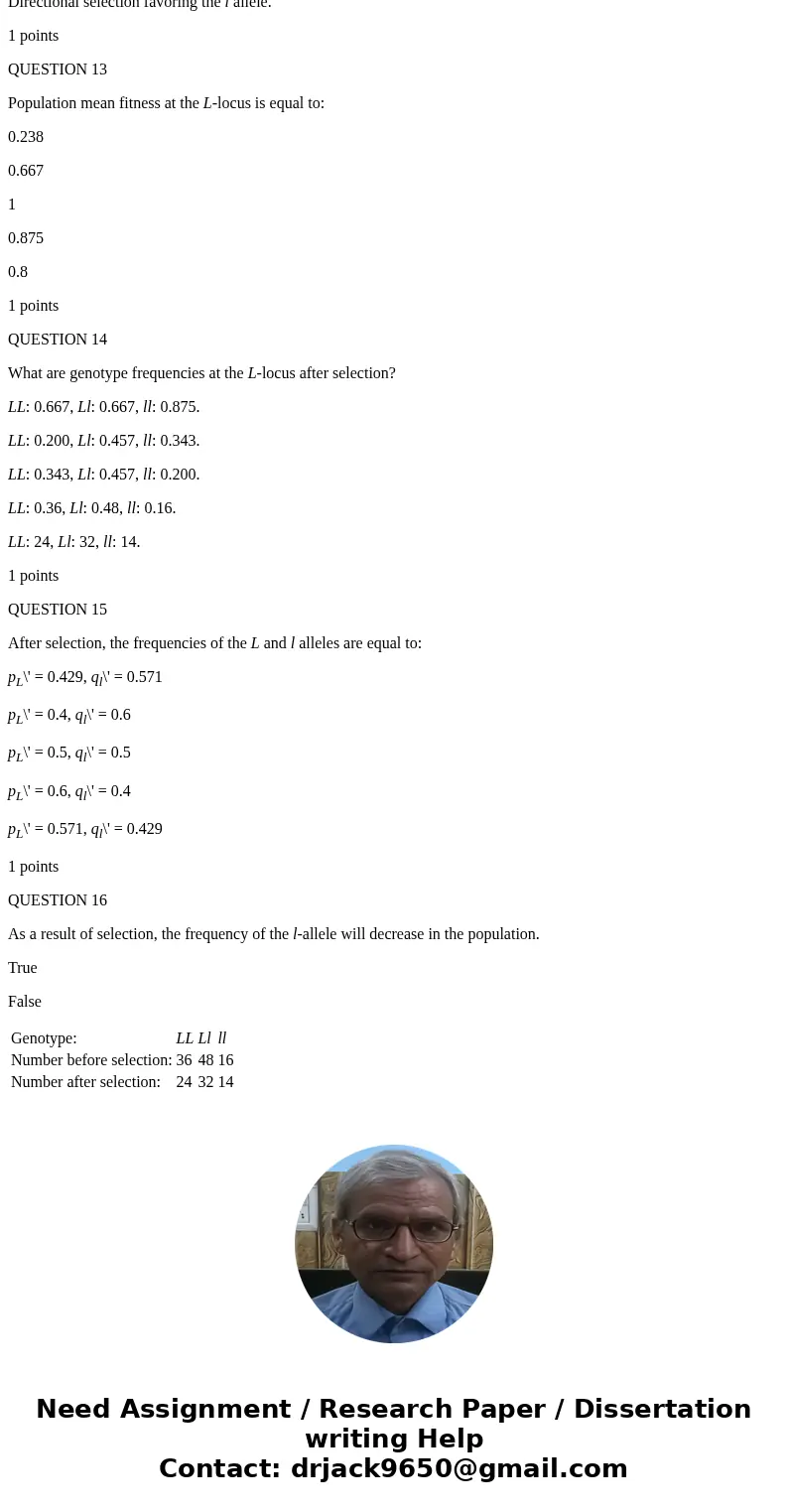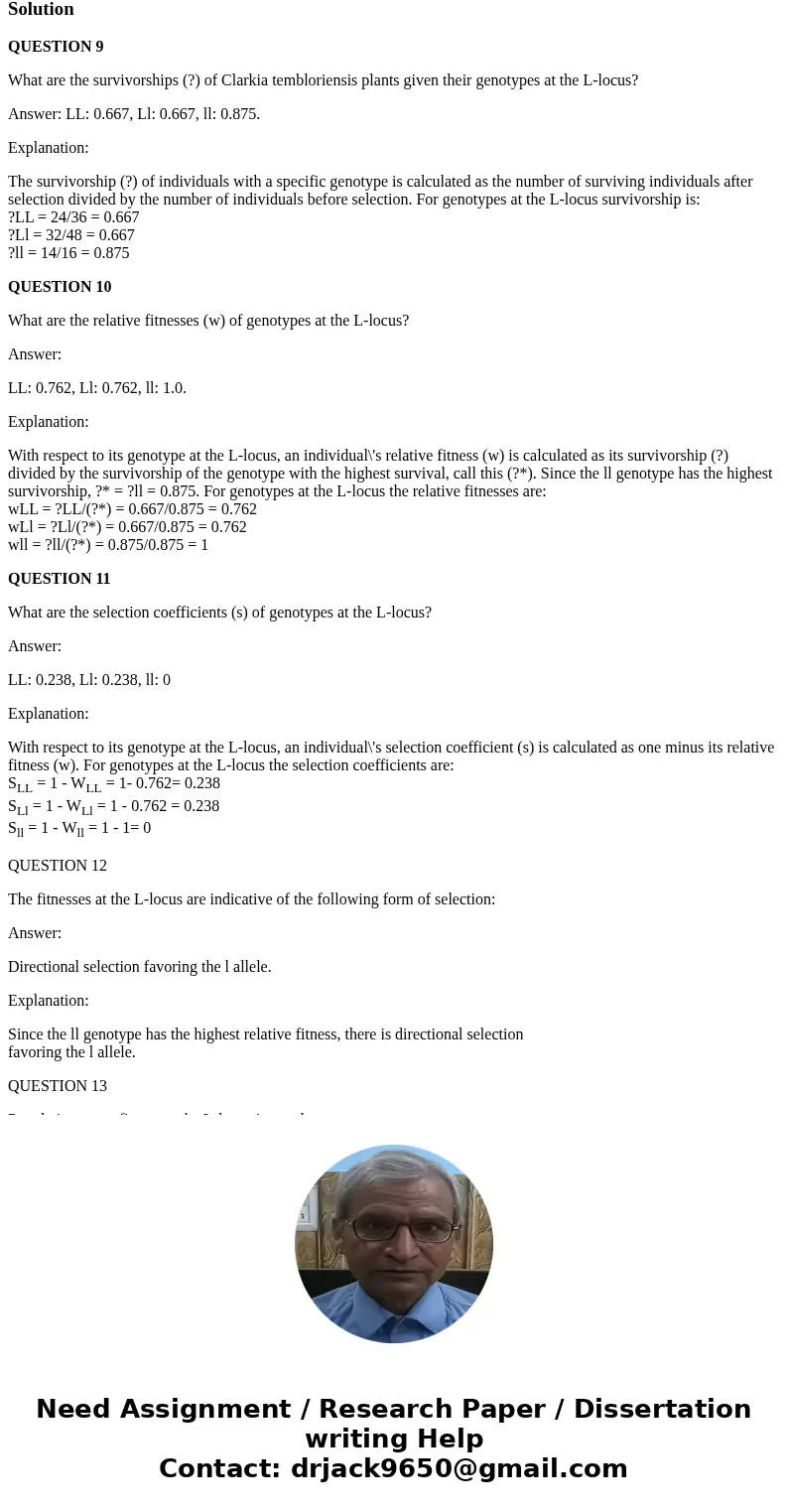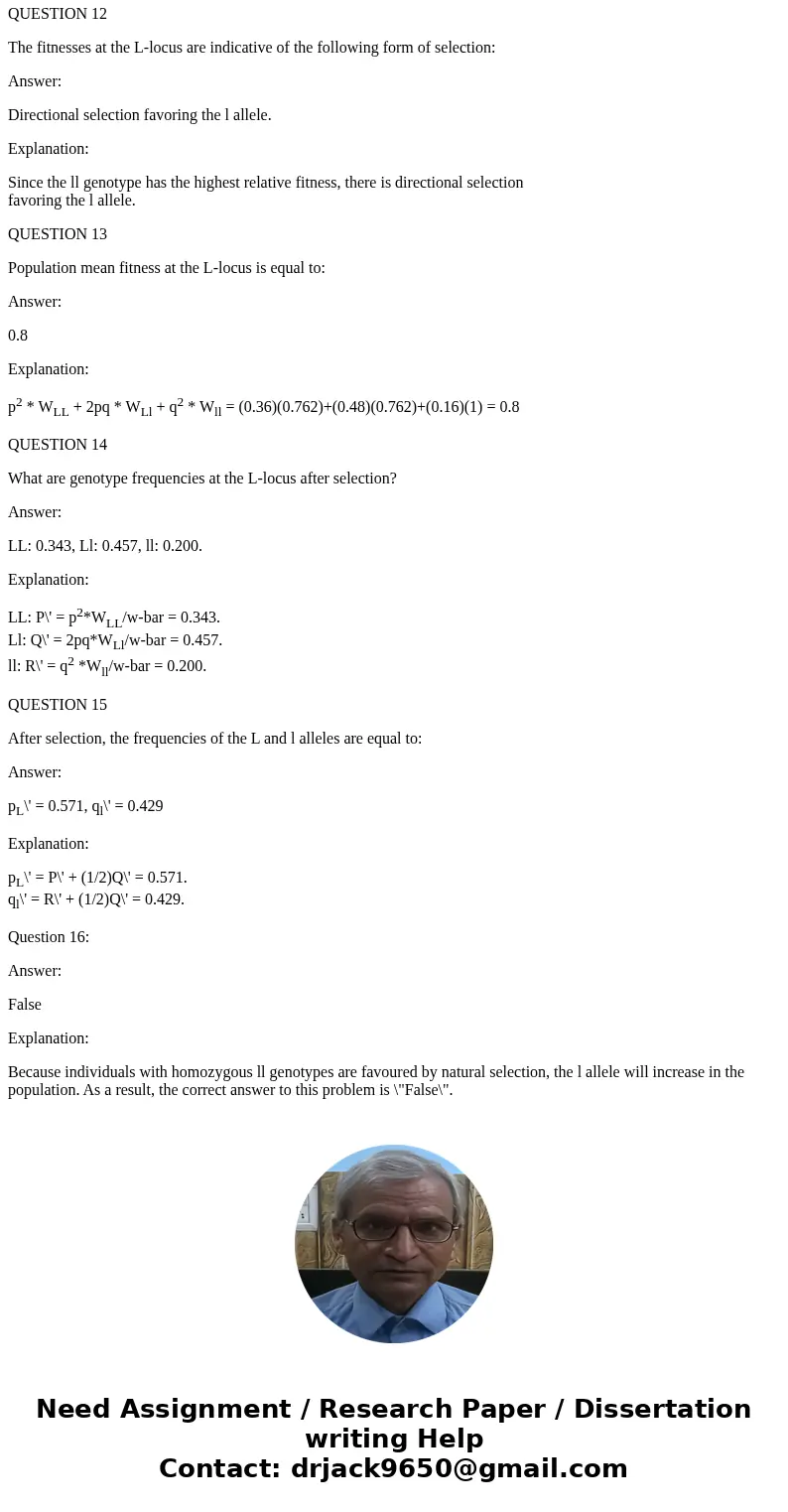QUESTION 9 Apply the general viability selection model to an
QUESTION 9
Apply the general viability selection model to answer the following hypothetical problem. In the plant Clarkia tembloriensis, temporal variation in germination date is under the control of a single locus, the L-locus. In dry habitats where pollinators are not abundant, the early germinating, recessive genotype (ll) is favored over the late germinating genotypes (LL and Ll). You will use the genotypic data presented in the table below in answering Questions 9-16:
What are the survivorships (?) of Clarkia tembloriensis plants given their genotypes at the L-locus?
LL: 0.667, Ll: 0.667, ll: 0.875.
LL: 0.36, Ll: 0.48, ll: 0.16.
LL: 1, Ll: 1, ll: 0.
LL: 0.343, Ll: 0.457, ll: 0.200.
LL: 0.875, Ll: 0.667, ll: 0.667.
1 points
QUESTION 10
What are the relative fitnesses (w) of genotypes at the L-locus?
LL: 0.36, Ll: 0.48, ll: 0.16.
LL: 0.667, Ll: 0.667, ll: 0.875.
LL: 0.762, Ll: 0.762, ll: 1.0.
LL: 1.0, Ll: 0.762, ll: 0.762.
LL: 0.343, Ll: 0.457, ll: 0.200.
1 points
QUESTION 11
What are the selection coefficients (s) of genotypes at the L-locus?
LL: 0.238, Ll: 0.238, ll: 0.
LL: 1.0, Ll: 0.762, ll: 0.762.
LL: 0.762, Ll: 0.762, ll: 1.0.
LL: 0, Ll: 0, ll: 0.238.
LL: 0.667, Ll: 0.667, ll: 0.875.
1 points
QUESTION 12
The fitnesses at the L-locus are indicative of of the following form of selection:
The genotypic variation at the L-locus is neutral with respect to selection.
Directional selection favoring the L allele.
Stabilizing selection favoring the Ll genotype.
Disruptive selection favoring the LL and ll genotypes.
Directional selection favoring the l allele.
1 points
QUESTION 13
Population mean fitness at the L-locus is equal to:
0.238
0.667
1
0.875
0.8
1 points
QUESTION 14
What are genotype frequencies at the L-locus after selection?
LL: 0.667, Ll: 0.667, ll: 0.875.
LL: 0.200, Ll: 0.457, ll: 0.343.
LL: 0.343, Ll: 0.457, ll: 0.200.
LL: 0.36, Ll: 0.48, ll: 0.16.
LL: 24, Ll: 32, ll: 14.
1 points
QUESTION 15
After selection, the frequencies of the L and l alleles are equal to:
pL\' = 0.429, ql\' = 0.571
pL\' = 0.4, ql\' = 0.6
pL\' = 0.5, ql\' = 0.5
pL\' = 0.6, ql\' = 0.4
pL\' = 0.571, ql\' = 0.429
1 points
QUESTION 16
As a result of selection, the frequency of the l-allele will decrease in the population.
True
False
| Genotype: | LL | Ll | ll |
| Number before selection: | 36 | 48 | 16 |
| Number after selection: | 24 | 32 | 14 |
Solution
QUESTION 9
What are the survivorships (?) of Clarkia tembloriensis plants given their genotypes at the L-locus?
Answer: LL: 0.667, Ll: 0.667, ll: 0.875.
Explanation:
The survivorship (?) of individuals with a specific genotype is calculated as the number of surviving individuals after selection divided by the number of individuals before selection. For genotypes at the L-locus survivorship is:
?LL = 24/36 = 0.667
?Ll = 32/48 = 0.667
?ll = 14/16 = 0.875
QUESTION 10
What are the relative fitnesses (w) of genotypes at the L-locus?
Answer:
LL: 0.762, Ll: 0.762, ll: 1.0.
Explanation:
With respect to its genotype at the L-locus, an individual\'s relative fitness (w) is calculated as its survivorship (?) divided by the survivorship of the genotype with the highest survival, call this (?*). Since the ll genotype has the highest survivorship, ?* = ?ll = 0.875. For genotypes at the L-locus the relative fitnesses are:
wLL = ?LL/(?*) = 0.667/0.875 = 0.762
wLl = ?Ll/(?*) = 0.667/0.875 = 0.762
wll = ?ll/(?*) = 0.875/0.875 = 1
QUESTION 11
What are the selection coefficients (s) of genotypes at the L-locus?
Answer:
LL: 0.238, Ll: 0.238, ll: 0
Explanation:
With respect to its genotype at the L-locus, an individual\'s selection coefficient (s) is calculated as one minus its relative fitness (w). For genotypes at the L-locus the selection coefficients are:
SLL = 1 - WLL = 1- 0.762= 0.238
SLl = 1 - WLl = 1 - 0.762 = 0.238
Sll = 1 - Wll = 1 - 1= 0
QUESTION 12
The fitnesses at the L-locus are indicative of the following form of selection:
Answer:
Directional selection favoring the l allele.
Explanation:
Since the ll genotype has the highest relative fitness, there is directional selection
favoring the l allele.
QUESTION 13
Population mean fitness at the L-locus is equal to:
Answer:
0.8
Explanation:
p2 * WLL + 2pq * WLl + q2 * Wll = (0.36)(0.762)+(0.48)(0.762)+(0.16)(1) = 0.8
QUESTION 14
What are genotype frequencies at the L-locus after selection?
Answer:
LL: 0.343, Ll: 0.457, ll: 0.200.
Explanation:
LL: P\' = p2*WLL/w-bar = 0.343.
Ll: Q\' = 2pq*WLl/w-bar = 0.457.
ll: R\' = q2 *Wll/w-bar = 0.200.
QUESTION 15
After selection, the frequencies of the L and l alleles are equal to:
Answer:
pL\' = 0.571, ql\' = 0.429
Explanation:
pL\' = P\' + (1/2)Q\' = 0.571.
ql\' = R\' + (1/2)Q\' = 0.429.
Question 16:
Answer:
False
Explanation:
Because individuals with homozygous ll genotypes are favoured by natural selection, the l allele will increase in the population. As a result, the correct answer to this problem is \"False\".




 Homework Sourse
Homework Sourse